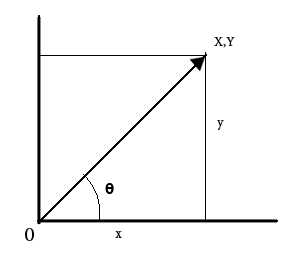
The X and Y components of a displacement vector are (15,7)m. Find the magnitude and direction of $ \vec A $ .
Answer
557.1k+ views
Hint : The magnitude of a vector is the length of the vector without consideration of its direction. The vector is given by the line joining the origin of a Cartesian plane to the point given as the components.
Formula used: In this solution we will be using the following formula;
$\Rightarrow \left| A \right| = \sqrt {{X^2} + {Y^2}} $ where $ \left| A \right| $ is the magnitude of any vector $ A $ , $ X $ is the x component and $ Y $ is the y component of the vector.
$\Rightarrow \theta = {\tan ^{ - 1}}\left( {\dfrac{Y}{X}} \right) $ , where $ \theta $ is the direction in angle.
Complete step by step answer
When the components of a vector are stated as (X,Y), this means that a line joining the point and the origin on a Cartesian plane, in the direction of the point, signifies the vector. The length of the line is the magnitude of the vector while the angle between the vector and the x-axis is considered the direction of the vector.
Hence, to calculate the length of the line, from mathematical principles,
$\Rightarrow \left| A \right| = \sqrt {{X^2} + {Y^2}} $ . Thus, substituting, the values of X and Y, we have
$\Rightarrow \left| A \right| = \sqrt {{{15}^2} + {7^2}} $ . Hence, by computation
$\Rightarrow \left| A \right| = 16.55m $ .
In finding the direction, angle from the x-axis, we have that
$\Rightarrow \theta = {\tan ^{ - 1}}\left( {\dfrac{Y}{X}} \right) $ , hence by substitution again, we have that
$\Rightarrow \theta = {\tan ^{ - 1}}\left( {\dfrac{7}{{15}}} \right) $
$\Rightarrow \theta = 0.44rad $ which can be converted to degree by multiplying by 180 over pi.
$\Rightarrow \theta = 0.44 \times \dfrac{{180}}{\pi } = 25^\circ $.
Note
The derivation for the magnitude and direction of a vector can be shown from the diagram below

We see the vector point to (XY) form 0, this is the hypotenuse of the right angled triangle. Hence, the length is given by the Pythagoras theorem, thus
$\Rightarrow L = \sqrt {{x^2} + {y^2}} $
And the angle is
$\Rightarrow \tan \theta = \dfrac{y}{x} $
$\Rightarrow \theta = {\tan ^{ - 1}}\dfrac{y}{x} $ .
Formula used: In this solution we will be using the following formula;
$\Rightarrow \left| A \right| = \sqrt {{X^2} + {Y^2}} $ where $ \left| A \right| $ is the magnitude of any vector $ A $ , $ X $ is the x component and $ Y $ is the y component of the vector.
$\Rightarrow \theta = {\tan ^{ - 1}}\left( {\dfrac{Y}{X}} \right) $ , where $ \theta $ is the direction in angle.
Complete step by step answer
When the components of a vector are stated as (X,Y), this means that a line joining the point and the origin on a Cartesian plane, in the direction of the point, signifies the vector. The length of the line is the magnitude of the vector while the angle between the vector and the x-axis is considered the direction of the vector.
Hence, to calculate the length of the line, from mathematical principles,
$\Rightarrow \left| A \right| = \sqrt {{X^2} + {Y^2}} $ . Thus, substituting, the values of X and Y, we have
$\Rightarrow \left| A \right| = \sqrt {{{15}^2} + {7^2}} $ . Hence, by computation
$\Rightarrow \left| A \right| = 16.55m $ .
In finding the direction, angle from the x-axis, we have that
$\Rightarrow \theta = {\tan ^{ - 1}}\left( {\dfrac{Y}{X}} \right) $ , hence by substitution again, we have that
$\Rightarrow \theta = {\tan ^{ - 1}}\left( {\dfrac{7}{{15}}} \right) $
$\Rightarrow \theta = 0.44rad $ which can be converted to degree by multiplying by 180 over pi.
$\Rightarrow \theta = 0.44 \times \dfrac{{180}}{\pi } = 25^\circ $.
Note
The derivation for the magnitude and direction of a vector can be shown from the diagram below

We see the vector point to (XY) form 0, this is the hypotenuse of the right angled triangle. Hence, the length is given by the Pythagoras theorem, thus
$\Rightarrow L = \sqrt {{x^2} + {y^2}} $
And the angle is
$\Rightarrow \tan \theta = \dfrac{y}{x} $
$\Rightarrow \theta = {\tan ^{ - 1}}\dfrac{y}{x} $ .
Recently Updated Pages
Master Class 11 Chemistry: Engaging Questions & Answers for Success

Why are manures considered better than fertilizers class 11 biology CBSE

Find the coordinates of the midpoint of the line segment class 11 maths CBSE

Distinguish between static friction limiting friction class 11 physics CBSE

The Chairman of the constituent Assembly was A Jawaharlal class 11 social science CBSE

The first National Commission on Labour NCL submitted class 11 social science CBSE

Trending doubts
What is meant by exothermic and endothermic reactions class 11 chemistry CBSE

10 examples of friction in our daily life

One Metric ton is equal to kg A 10000 B 1000 C 100 class 11 physics CBSE

Difference Between Prokaryotic Cells and Eukaryotic Cells

What are Quantum numbers Explain the quantum number class 11 chemistry CBSE

1 Quintal is equal to a 110 kg b 10 kg c 100kg d 1000 class 11 physics CBSE




